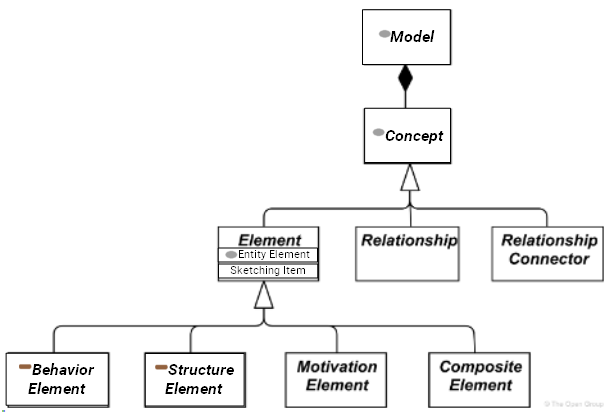IDENTITY - ArchiMate - Top-Level Language Structure
| Description | Model is a collection of concepts – a concept is either an element or a relationship An element is either a behavior element, a structure element, a motivation element, or a composite element Note that these are abstract concepts; they are not intended to be used directly in models. To signify this, they are depicted in white with labels in italics. |
|---|---|
| References | OpenGroup - ArchiMate - Top Level Language Structure |
| Parent Mapping | ArchiMate Mapping |
| Corresponding SysFEAT Domain | Top-Level Language Structure |

MAPPED ENTITIES
| Framework Concept | Framework Definition | SysFEAT Concept | SysFEAT Definition |
|---|---|---|---|
 Behavior Element Behavior Element |
 Behavior
Behavior |
A Behavior is an Operating Asset that describes any action or reaction of an Agent to external or internal Behavioral Events. Behaviors include Action Processes (action), Interaction Processs (stories) or interactions (Service Interface). The course of actions of a Behavior is constrained ( Rule Enforcement) by the application of Behavioral Rules that define what is allowed and not allowed to do. References: ISO 15926 - ClassOfActivity OMG - KerML - Behavior OMG - UML - Behavior OpenGroup - ArchiMate - Behavior-Elements Russell Ackoff - System of Concepts - Behavior WordNet - Behavior and Activity |
|
 Concept Concept |
 Element
Element |
An Element is an elementary constituent of a model. It is the top level abstraction of the SysFEAT upper ontology. References: ISO 15926 - Thing OMG - KerML - Element OpenGroup - ArchiMate - Concept |
|
 Entity Element Entity Element |
References: OpenGroup - ArchiMate - Element |
 Entity Element
Entity Element |
An Entity Element is a distinct, identifiable Element that has a proper existence (living or non living). It is accessible by some referencing mechanism and can establish elementary relationships (Relationship Element) to other Entity Elements. References: DDD - Glossary - Entity ISO 15926 - Thing OMG - KerML - Element OpenGroup - ArchiMate - Element |
 Model Model |
 Container
Container |
A Container is a collection of Building Blocks whose existence and meaning are defined by the Container. A Container is both: 1. A Lexical Scope: the meaning and usage of a Building Block is only applicable within the context of the Container to which it belongs. 2. A universe of discourse: the complete range of Building Blocks that are expressed, assumed, or implied in an architecture domain. Examples: - Library - Enterprise References: Blog - Explain lexical scope in plain English Collins - universe-of-discourse OMG - KerML - Namespace OMG - UML - Namespace |
|
 Sketching Item Sketching Item |
References: OpenGroup - ArchiMate - Element |
||
 Structure Element Structure Element |
 Agent
Agent |
An Agent is an Operating Asset which is able to participate actively to Behaviors, to produce and react to Outcome Events. 1. Agents participate to Action Processes (Active Participant) and/or conduct Action Processes (Performed Process). 2. Agents participate to Interaction Process (Scenario Participant) describing how they interact with other Agents. These actions and interactions define Agents boundaries described by Service Interfaces. References: Christensen Institute - Modularity ISO 15926 - ClassOfPossibleRoleAndDomain OMG - KerML - Structure OMG - UML - EncapsulatedClassifier OpenGroup - ArchiMate - Internal Active Structure Element OpenGroup - OAA - Modularity OpenGroup - TOGAF - Definition - System Russell Ackoff - System of Concepts - Abstract System WordNet - Agent |
EXTERNAL REFERENCES
| Framework reference | SysFEAT Description |
|---|---|
 OpenGroup - ArchiMate - Element OpenGroup - ArchiMate - Element |
 Entity Element
Entity ElementAn Entity Element is a distinct, identifiable Element that has a proper existence (living or non living). It is accessible by some referencing mechanism and can establish elementary relationships (Relationship Element) to other Entity Elements.  Functional Asset
Functional Asset Functional Assets encompasse all Architecture Asset Types used to describe why and how systems operate/function. This includes the Operating Eco-System where system operates to fulfill these purposes (Agents and their Behaviors). Functional Assets include: 1. Blocks defining results of Behaviors of the enterprise or its sub-systems, that benefit to it internal or external customers : Outcome Event, 2. Blocks used to describe information: Information Asset. 3. Blocks used to describe how the enterprise operates: Operating Assets (Agent, Behavior, Service Interface). |